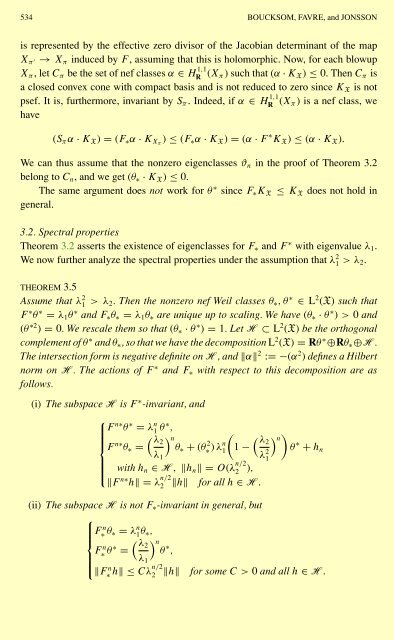A NULLSTELLENSATZ FOR AMOEBAS
A NULLSTELLENSATZ FOR AMOEBAS
A NULLSTELLENSATZ FOR AMOEBAS
Create successful ePaper yourself
Turn your PDF publications into a flip-book with our unique Google optimized e-Paper software.
534 BOUCKSOM, FAVRE, and JONSSON<br />
is represented by the effective zero divisor of the Jacobian determinant of the map<br />
X π ′ → X π induced by F , assuming that this is holomorphic. Now, for each blowup<br />
X π ,letC π be the set of nef classes α ∈ H 1,1<br />
R<br />
(X π) such that (α · K X ) ≤ 0.ThenC π is<br />
a closed convex cone with compact basis and is not reduced to zero since K X is not<br />
psef. It is, furthermore, invariant by S π . Indeed, if α ∈ H 1,1<br />
R<br />
(X π) is a nef class, we<br />
have<br />
(S π α · K X ) = (F ∗ α · K Xπ ) ≤ (F ∗ α · K X ) = (α · F ∗ K X ) ≤ (α · K X ).<br />
We can thus assume that the nonzero eigenclasses ϑ n in the proof of Theorem 3.2<br />
belong to C n , and we get (θ ∗ · K X ) ≤ 0.<br />
The same argument does not work for θ ∗ since F ∗ K X ≤ K X does not hold in<br />
general.<br />
3.2. Spectral properties<br />
Theorem 3.2 asserts the existence of eigenclasses for F ∗ and F ∗ with eigenvalue λ 1 .<br />
We now further analyze the spectral properties under the assumption that λ 2 1 >λ 2.<br />
THEOREM 3.5<br />
Assume that λ 2 1 >λ 2. Then the nonzero nef Weil classes θ ∗ ,θ ∗ ∈ L 2 (X) such that<br />
F ∗ θ ∗ = λ 1 θ ∗ and F ∗ θ ∗ = λ 1 θ ∗ are unique up to scaling. We have (θ ∗ · θ ∗ ) > 0 and<br />
(θ ∗2 ) = 0. We rescale them so that (θ ∗ · θ ∗ ) = 1. LetH ⊂ L 2 (X) be the orthogonal<br />
complement of θ ∗ and θ ∗ , so that we have the decomposition L 2 (X) = Rθ ∗ ⊕Rθ ∗ ⊕H.<br />
The intersection form is negative definite on H, and ‖α‖ 2 :=−(α 2 ) defines a Hilbert<br />
norm on H. The actions of F ∗ and F ∗ with respect to this decomposition are as<br />
follows.<br />
(i) The subspace H is F ∗ -invariant, and<br />
⎧<br />
F n∗ θ ∗ = λ n 1 θ ∗ ,<br />
( ⎪⎨ λ2<br />
) (<br />
nθ∗<br />
F n∗ θ ∗ = + (θ 2 ∗<br />
λ ) λn 1<br />
1 −<br />
1<br />
with h ⎪⎩<br />
n ∈ H, ‖h n ‖=O(λ n/2<br />
2 ),<br />
‖F n∗ h‖=λ n/2<br />
2 ‖h‖ for all h ∈ H.<br />
( λ2<br />
λ 2 1<br />
) n<br />
)<br />
θ ∗ + h n<br />
(ii) The subspace H is not F ∗ -invariant in general, but<br />
⎧<br />
F∗ ⎪⎨<br />
nθ ∗ = λ n 1 θ ∗,<br />
(<br />
F∗ nθ λ2<br />
) nθ ∗ =<br />
∗ ,<br />
λ 1<br />
⎪⎩ ‖F∗ nh‖≤Cλn/2<br />
2 ‖h‖ for some C>0 and all h ∈ H.
















